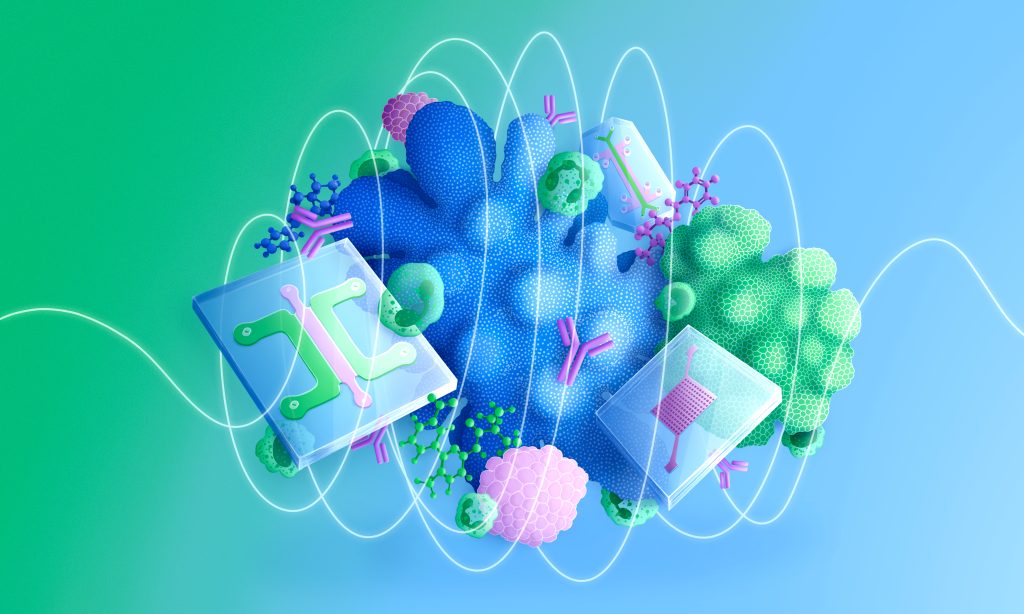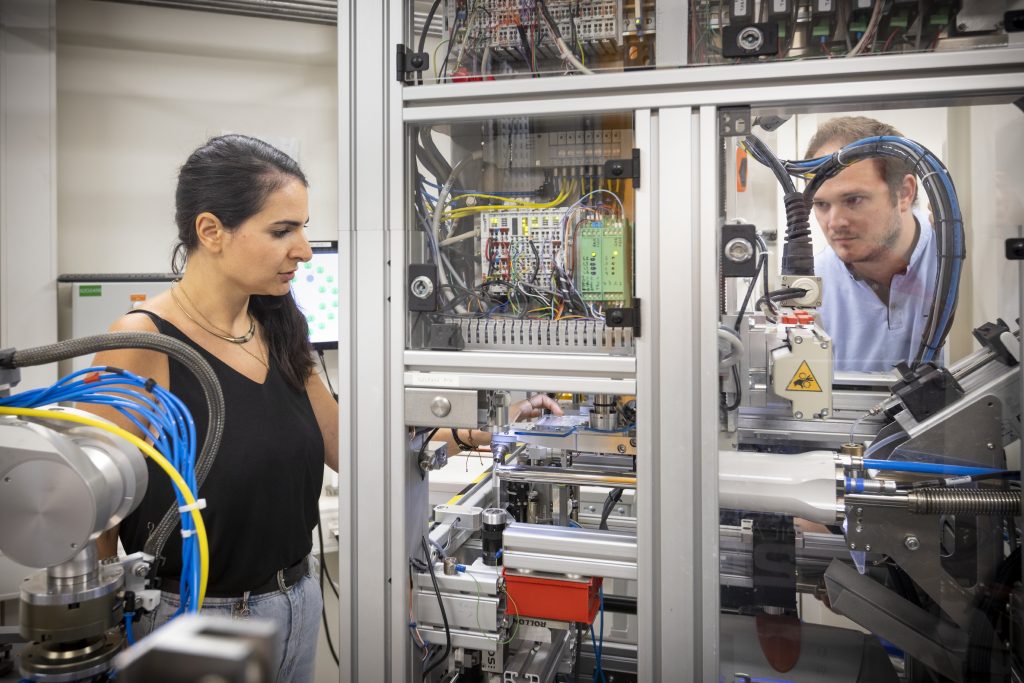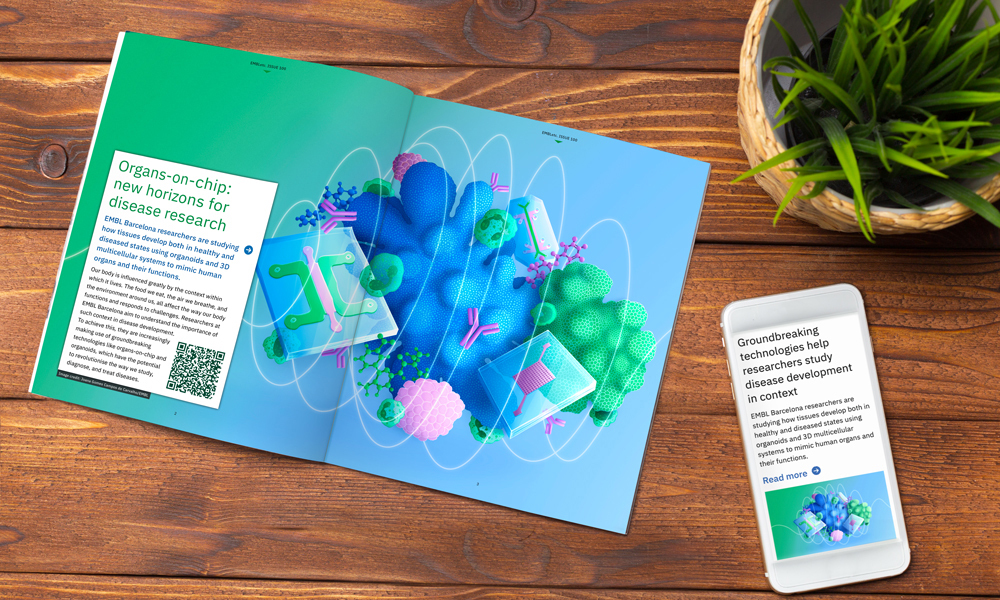
Organs-on-chip: new horizons for disease research
EMBL Barcelona researchers are studying how tissues develop in health and disease using organoids and 3D multicellular systems to mimic human organs and their functions.
Issue 100
EMBLetc., the online magazine of Europe’s life sciences laboratory, celebrates its 24th birthday with its 100th issue. We took a walk through the past issues of this dynamic publication, and here are 10 recurring themes that emerged.

EMBLetc. began its journey as a black-and-white printed newsletter in 1998, with the goal of providing “news about services, staff, science and society” to EMBL staff and alumni. It was created by EMBL’s Office of Information and Public Affairs (which later became the EMBL Communications office) and acted for many years as a one-stop shop for news, announcements, essays, opinions, and trivia related to EMBL’s research and its people.
In recent years, EMBLetc. has grown into an important channel for communicating the impact of EMBL’s activities to the wider community in our member states as well as globally. During this time, it has passed through the able hands of various editors, including Sarah Sherwood, Charlotte Otter, Vienna Leigh, Adam Gristwood, Chloe Cross, Ed Dadswell, Oana Stroe, and Ivy Kupec.
It has also undergone many transformations, both in content and format. From the very early issues that were both personal and informal, directed primarily towards staff and alumni, it has evolved into a dazzling showcase of the activities and achievements of the institute and its people on various fronts, gaining a global readership and aided by the creation of new complementary internal communication channels. In terms of format, for EMBL’s 40th anniversary in 2014, it was redesigned as a biannual magazine, and with the 99th issue that came out in November 2022, it became a fully digital publication, in line with EMBL’s current sustainability initiatives.
On the occasion of EMBLetc.’s 100th issue, we took a quick look at the most recent 24 years of the organisation’s history through the lens of its issues. And we found a set of common themes that came up again and again in its pages.
As research highlights in all 99 issues of EMBLetc. show, EMBL is a world leader in cutting-edge life science research, pushing the boundaries of both fundamental and applied research to reveal exciting insights about how organisms function. Here are a few examples of EMBL’s groundbreaking science from the last 24 years.
Two of EMBL’s key missions are to offer vital services to scientists in the member states and the world and to train scientists, students, and visitors at all levels. As the following clippings show, this is something that EMBL has achieved and encouraged right from its early days.
Another EMBL mission is to coordinate and integrate European life science research, by stablishing links and initiating collaborative projects between scientists in Europe and the wider world. As these clippings from past EMBLetc. issues show, our many collaborations, partnerships, and connections are among our biggest strengths.
In addition to core funding from its member states, EMBL has been repeatedly successful in attracting monetary support from those who believe in its mission and using such funding to expand the range of its many contributions to the scientific community. Here are a few examples.
EMBL’s fourth mission is to actively engage in technology transfer and industry relations. Among other programmes, this includes the EMBL corporate partnership programme, the EMBL-EBI industry programme, and technology transfer via EMBLEM, an affiliate and the commercial arm of EMBL. The following clippings demonstrate some of the early roots of this mission.
The first EMBLetc. issue coincided with EMBL Monterotondo (now known as EMBL Rome) opening its doors. Over the last three decades, we have seen new sites and buildings come up, new facilities established, and new directions embarked upon.
EMBL’s unique employment structure results in a continuously growing and thriving alumni community. From the beginning, alumni have been closely involved in the production of EMBLetc. and forms one of its biggest readerships. The EMBL Alumni Relations programme helps nurture a vibrant and engaged community of current and former staff and friends worldwide.
For many years, EMBLetc. carried a regular column that shed light on the activities of all the people who kept the campus going “behind the scenes”. It also highlighted the many achievements of its predoctoral and postdoctoral fellows and frequently featured contributions from them.
Summer parties, Burns nights, Lab Days – whatever be the occasion, EMBLers just love getting together and letting their hair down. Here are some festive highlights from past years.
EMBLetc. Has been a conduit for creativity as well as humour over the course of its existence. Enjoy this insight into the brilliant and nerdy minds of some of those who have passed through EMBL’s halls.
…and that’s a wrap! Don’t forget to visit our archives to browse through all 100 issues of EMBLetc. To visit the newest issue, please head here, or download a printable preview here.
Do you have an EMBL memory you would like to share or an idea for a new EMBLetc. story? Please write to us with your feedback and suggestions!

EMBL Barcelona researchers are studying how tissues develop in health and disease using organoids and 3D multicellular systems to mimic human organs and their functions.

EMBL Grenoble technology teams provide a sneak peek into their latest collaborative project in structural biology services: the complete automation of an integral step in X-ray crystallography.

Click here to download a quick overview of all the articles included in this digital issue of EMBLetc.